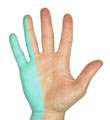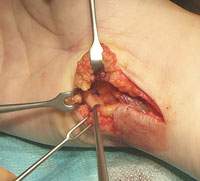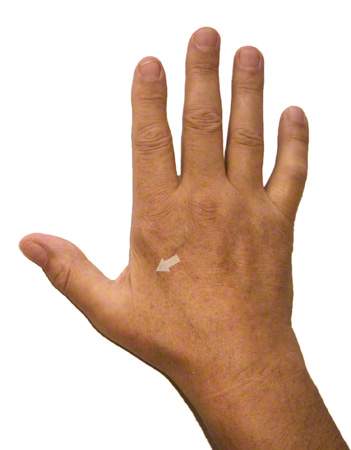Picture: Typical findings of Loge de Guyon syndrome with muscle atrophy between the 1st and 2nd metacarpal bone.
Similar to carpal tunnel syndrome, Loge de Guyon syndrome is caused by a constriction in a nerve lobe. Here too, the actual cause often remains hidden. Occasionally, however, tenosynovitis or a ganglion can be found. As with carpal tunnel syndrome, poorly healed fractures or wear-related changes (osteoarthritis) can also be found as rarities.
Loge de Guyon syndrome is not atypical in cycling. The bicycle handlebars, which literally hammer against the ball of the little finger when riding, cause compression in the Guyon’s box and then pressure damage to the ulnar nerve.
Anatomy:
The ulnar nerve(nervus ulnaris) runs in the wrist area through a ligament calledthe“Loge de Guyon“. It is located on the ulnar side of the carpal tunnel (close to the ball of the little finger) and is delimited by various ligaments. In the area of the Loge de Guyon, the ulnar nerve is divided into a superficial and a deep nerve branch. The superficial branch is responsible for the sensation of the little finger and the ulnar half of the ring finger. The deep branch, on the other hand, is a motor branch that supplies the small muscles of the hand.
What are the typical symptoms of Loge de Guyon syndrome?

In most cases, Loge de Guyon syndrome is characterized by a reduction in the strength of the small hand muscles supplied by the ulnar nerve. Those affected have problems spreading their fingers apart and bringing them together. Pain in the area of the ulnar carpus is sometimes present. Furthermore, the sensation in the little finger and ring finger (on the little finger side) can be reduced. A loss of sensation is also possible. Patients often complain of tingling or numbness in the little finger.
With the progression of Loge de Guyon syndrome, a tightening of the above-mentioned small hand muscles (see illustration at the top of this page) can be observed. This also applies to some of the muscles in the ball of the thumb. Small depressions form between the metacarpal bones on the extensor side, which are particularly noticeable in a lateral comparison. The deformity results in an imbalance of the musculature and consequently a so-called claw hand.
Loge de Guyon syndrome must be distinguished from ulnar sulcus syndrome. The latter is a constriction of the ulnar nerve at the level of the crook of the elbow. The extensor side of the back of the hand on the little finger side is supplied by a nerve branch that branches off from the Loge de Guyon close to the body. So if there are sensory disturbances in this area, it cannot just be a case of Loge de Guyon syndrome!
How is Loge de Guyon syndrome treated?
The following things are important before treating Loge de Guyon syndrome:
The measurement of the “nerve currents” (= ENG / EMG) by a neurologist (= neurologist) should confirm the suspicion of Loge de Guyon syndrome. Compression of the ulnar nerve at the elbow as part of ulnar sulcus syndrome should also be ruled out. This measurement is essential before an operation and should be relatively recent so that you have a reference for the follow-up examinations after the operation.
What options are there for conservative treatment?
Conservative treatment should be attempted before surgery for Loge de Guyon syndrome, if the symptoms and the electrophysiological examination by the neurologist allow it. There are various therapeutic approaches. Vitamin B6 preparations and non-steroidal anti-inflammatory drugs (NSAIDs) are often prescribed. A night splint can also help to alleviate the symptoms. It is particularly important to eliminate the triggering causes that lead to pressure damage in the Loge de Guyon.
The operation for Loge de Guyon syndrome.

Advanced Loge de Guyon syndrome should be operated on, especially in cases of muscle atrophy, before irreparable damage to the ulnar nerve occurs.
Endoscopic or minimally invasive surgical techniques are hardly possible due to the small dimensions of the Loge de Guyon. Similar to the conventional technique for splitting the carpal ligament in carpal tunnel syndrome, an approx. 4-5 cm long curved skin incision is made, but on the wrist on the little finger side.
The ulnar nerve is then traced until it bifurcates into the superficial and deep nerve branches. The roof (ligament structure) of Guyon’s box is now split and the ulnar nerve is freed from constricting structures (tendon sheaths, ganglion, etc.).
The operation can be performed on an outpatient basis if there are no reasons (secondary diseases) for not doing so. The procedure is performed under intravenous regional anesthesia (underarm anesthesia), plexus anesthesia (anesthesia in the armpit) or, in special cases, under general anesthesia.
What should I bear in mind after the operation?
It can take several weeks for the symptoms to improve. In very advanced cases, the ulnar nerve is often damaged to such an extent that adequate recovery of the loss of sensation and weakness of the small hand muscles cannot be expected. The indication for surgery should therefore not be made too late.
We recommend wearing a plaster splint for 3-5 days. Careful movement exercises can be started from the third postoperative day. Physiotherapy is important, depending on the severity of the Loge de Guyon syndrome, in order to rebuild the spared muscles and to restore muscular balance in the case of an incipient claw hand. The stitches are removed after two weeks. We recommend a neurological-electrophysiological check-up with a neurologist after approx. 3-6 months.


